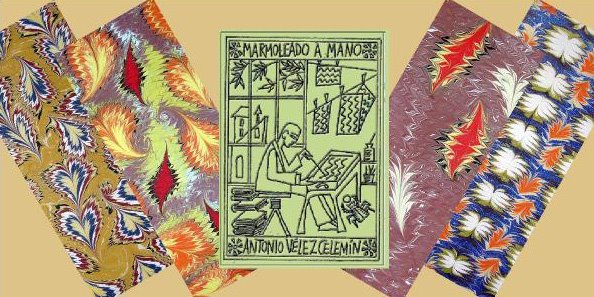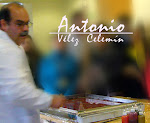the technique she uses is paste papers,
more known nowadays.
 I have obtained a photo of her in the fair of bookbinding of Cologne,
I have obtained a photo of her in the fair of bookbinding of Cologne,where she was with her papers
and with her books.
Because Susanne is versatile,she does not limit herself to paint papers,
but also she writes and publish her own books.
One of Susanne's phrases that more attracted my attention
was that one in which she mentions that
every generation loses some secret of some technique of paper decoration.
With every master who disappears
it disappears also some formidable trick that only he knew.
That's why it is so important not only to maintain the production of decorated papers,
but to spread the decorative techniques with teaching and, why not,
with the publication of works that are
the archive that we bequeath to future generations.
 Susanne's first book, in collaboration with Ilona Hesse,
Susanne's first book, in collaboration with Ilona Hesse,was a small review of the different paper decoration techniques:
On handmade decorated papers (ISBN 9783938423158),
with two editions, the first one in 2000 and the second one in 2007.
 The second one a specific work on her technique:
The second one a specific work on her technique:More on paste papers (ISBN 3-938423-07-2),
published on 2005.
 The third one, in 2007,
The third one, in 2007,International decorated papers: beyond the sample book
(ISBN 9783938423202).
A luxurious compilation with original samples of 25 international artists.
And the fourth one …
...the fourth one is the one that I want to present to you now
and the reason of this article.
Susanne's last book,
newly published
was presented in the past Frankfurt bookfair,
a couple of weeks ago.
 Decorated paper: a guide book. (ISBN 978-3-938423-17-2)
Decorated paper: a guide book. (ISBN 978-3-938423-17-2)Under this simple title appears a fundamental book
for the recognition and appreciation of decorated papers,
of its diverse achievement techniques,
traditional ones and modern ones are included,
and of its designs.
The decorative techniques are not described
but the question is to recognize to which of them must belong
the paper that is possessed which could be identified
with this valuable help.
It is a field guide.
Just as a butterfly is seen in the field
and it’s made the research to identify its specie
with the help of a lepidopterous’ guide,
a decorated paper appears in the endleaves of a book,
or in another place,
that will be identified
with Susanne's new book.

The descriptions are simple and clear
and the illustrations, 113 full colored,
come from the funds of the collection of decorated papers
of the Royal Library of The Hague;
of the German Museum of the Book and Writing (Leipzig);
of the Library of the princess Ann Amalia (Weimar)
and of private collections
and artists.
The text appears in three languages:
German, Dutch and English
and was written by specialists of the mentioned institutions:
Henk Porck, Julia Rinck, Frieder Schmidt and Ida Schrijver.
Any more guarantees cannot be asked.
Nothing more than to wish an enormous success to this publication
that confirms the great interest that exists at present in this topic.
A work that should be present in any library,
private or public.
I hope that soon there could be the second edition,
with even more illustrations...
... and with the text also in Spanish,
something really easy to solve.
or by mail to studio@hamburgerbuntpapier.de























































